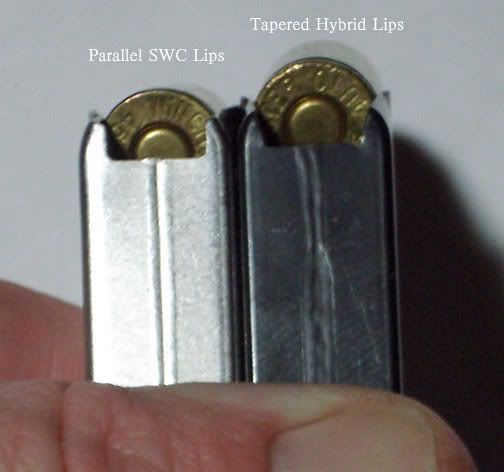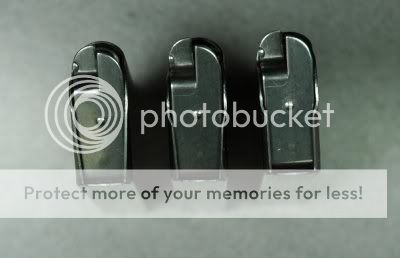Inevitably, the talk eventually turns to magazines, and over the years people have asked me why I'm such a hound for the tapered feed lips of the "Hybrid" and the standard old USGI sticks. I try to explain it as carefully as I can, but many can't seem to see it...mainly because they've only been exposed to the trendy wadcutter "gamer" type magazines.
So...a picture bein' worth a thousand or so words...I thought I might do a show and tell instead of just a tell.
Pictured below are two 7 round magazines.
Both have the original design follower with the silly little dimple on top. The cartridges in these magazines have been pushed forward until the rims stopped against the dimple, which is just shy of the release point.
On the left is a wadcutter type magazine with the parallel feed lips and timed release point. On the right, a Hybrid with the tapered lips, and also with a timed release point. The Hybrid's release point comes a tic later and is just a little less abrupt than the wadcutter's.
As you can see, the Hybrid's tapered lips allow the rear of the cartridge to rise as it moves forward. This accomplishes two things. First, it lowers the angle of approach, making it nearly a straight shot into the chamber. Second, and most importantly, the extractor starts to pick up the rim before the feed lips release it, making it much less likely for control of the round to be lost. With a proper, within-spec GI or "Hardball" magazine, the rim is well under the extractor when it finally releases, thus insuring that the round will remain under control until the ejector kicks the empty case clear of the port.
The Wadcutter magazine was designed to be at its best with short OALsemi-wadcutter ammunition, and in that role, it shines. If control is lost due to the early, abrupt release causing the gun to push feed the round...assuming that the extractor is within spec as to deflection and the angle on the nose, the claw will cam open and effect a successful return to battery. The Wadcutter design also works well with the truncated cone bullet shape at shorter OALs.
That nose angle was one of Browning's redundancies, and it provided a way to single load the gun in the event of a lost or damaged magazine. It's not good for the extractor, but it can be done in an emergency without harm. You just don't want it to do that with every round, or even once per magazine, but if it's life and death...go for it.
The full tapered Hardball magazine works best with hardball's longer OAL (1.265-1.275) but will work okay with the Hensley & Gibbs #68 SWC at 1.250 inch...most of the time...as long as the barrel ramp is modified for the sharp shoulder of the SWC.
Enter the Hybrid. This was a Colt design that goes back to the early 80s, and combines the butt rising, later, gradual release of the GI with the timed, abrupt release of the Wadcutter, which makes it work well with the typically shorter hollowpoint ammunition with the ogive shape similar to ball. It also shines with the #68 H&G bullet. The Hybrid sprang directly from the old AMU armorers' punch and die that formed a timed release point into the hardball magazines...which was all they had to work with back in the day. It worked very well then, and it still does.
So, cast your eyeballs on this picture, and you can see the differences and understand Browning's reasoning behind his magazine design.

So...a picture bein' worth a thousand or so words...I thought I might do a show and tell instead of just a tell.
Pictured below are two 7 round magazines.
Both have the original design follower with the silly little dimple on top. The cartridges in these magazines have been pushed forward until the rims stopped against the dimple, which is just shy of the release point.
On the left is a wadcutter type magazine with the parallel feed lips and timed release point. On the right, a Hybrid with the tapered lips, and also with a timed release point. The Hybrid's release point comes a tic later and is just a little less abrupt than the wadcutter's.
As you can see, the Hybrid's tapered lips allow the rear of the cartridge to rise as it moves forward. This accomplishes two things. First, it lowers the angle of approach, making it nearly a straight shot into the chamber. Second, and most importantly, the extractor starts to pick up the rim before the feed lips release it, making it much less likely for control of the round to be lost. With a proper, within-spec GI or "Hardball" magazine, the rim is well under the extractor when it finally releases, thus insuring that the round will remain under control until the ejector kicks the empty case clear of the port.
The Wadcutter magazine was designed to be at its best with short OALsemi-wadcutter ammunition, and in that role, it shines. If control is lost due to the early, abrupt release causing the gun to push feed the round...assuming that the extractor is within spec as to deflection and the angle on the nose, the claw will cam open and effect a successful return to battery. The Wadcutter design also works well with the truncated cone bullet shape at shorter OALs.
That nose angle was one of Browning's redundancies, and it provided a way to single load the gun in the event of a lost or damaged magazine. It's not good for the extractor, but it can be done in an emergency without harm. You just don't want it to do that with every round, or even once per magazine, but if it's life and death...go for it.
The full tapered Hardball magazine works best with hardball's longer OAL (1.265-1.275) but will work okay with the Hensley & Gibbs #68 SWC at 1.250 inch...most of the time...as long as the barrel ramp is modified for the sharp shoulder of the SWC.
Enter the Hybrid. This was a Colt design that goes back to the early 80s, and combines the butt rising, later, gradual release of the GI with the timed, abrupt release of the Wadcutter, which makes it work well with the typically shorter hollowpoint ammunition with the ogive shape similar to ball. It also shines with the #68 H&G bullet. The Hybrid sprang directly from the old AMU armorers' punch and die that formed a timed release point into the hardball magazines...which was all they had to work with back in the day. It worked very well then, and it still does.
So, cast your eyeballs on this picture, and you can see the differences and understand Browning's reasoning behind his magazine design.

Last edited:


